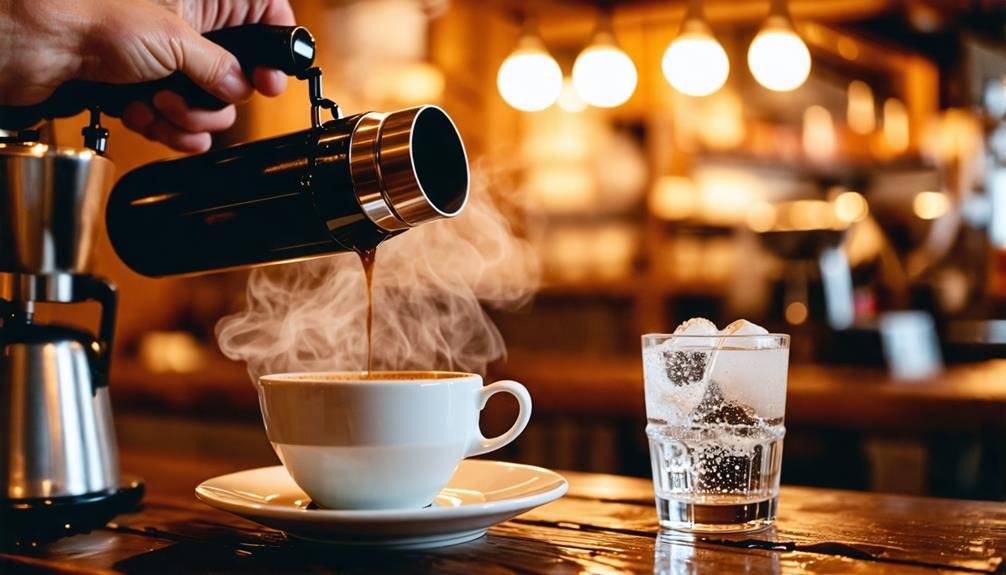Ordering a latte in Italy often yields a glass of milk because the term "latte" translates directly to "milk" in Italian, lacking the espresso component many expect. To enjoy a creamy espresso and milk blend, request a "caffè latte," which combines Lavazza espresso with steamed milk. Alternatively, a cappuccino—made with equal parts espresso, steamed milk, and foamed milk—is perfect for those seeking a rich flavor. Italians typically reserve cappuccinos for mornings and favor quick espresso shots in the afternoon. Understanding these distinctions deepens appreciation for Italy's unique coffee culture and its traditional beverage offerings.
Understanding the Italian Coffee Menu
Understanding the Italian coffee menu requires knowledge of distinct terms and offerings that define Italy's rich coffee culture. In Italy, the term 'latte' typically denotes a glass of milk, unlike the popular espresso-based drink known to many outside the country. To enjoy a creamy coffee experience, one should specifically order a 'caffè latte.' This beverage combines rich espresso from brands like Lavazza with steamed milk, creating a delightful balance of flavors.
Coffee order etiquette in Italy emphasizes simplicity and authenticity. For instance, cappuccinos, which blend espresso with foamed milk, are traditionally enjoyed in the morning and rarely ordered after 11 a.m. Locals often prefer a quick shot of caffè (espresso) in the afternoon, showcasing the cultural preference for stronger coffee options. Moreover, it is customary to pay for coffee after consumption, further highlighting the informal yet respectful nature of Italian coffee culture.
What to Order Instead of a Latte
When ordering coffee in Italy, clarity is key. A basic request for 'latte' will result in a glass of milk instead of the desired espresso drink. Instead, opt for a caffè latte, a delightful combination of espresso and steamed milk, offering a creamy coffee experience.
Another favored choice is the cappuccino, featuring robust espresso topped with frothy milk. This beverage holds a special place in Italian tradition and is typically enjoyed in the morning. Specialty cappuccinos may even showcase artistic designs on the foam, enhancing both taste and visual appeal.
For those desiring a refreshing option, try the caffè freddo, a chilled and sweetened espresso drink, ideal for hot days. By selecting these authentic Italian beverages, you not only celebrate Italy's rich coffee tradition but also enrich your culinary journey. When in Italy, choosing local specialties over generic terms will heighten your appreciation for the vibrant coffee culture that defines this remarkable country.
Exploring Caffè Latte and Cappuccino
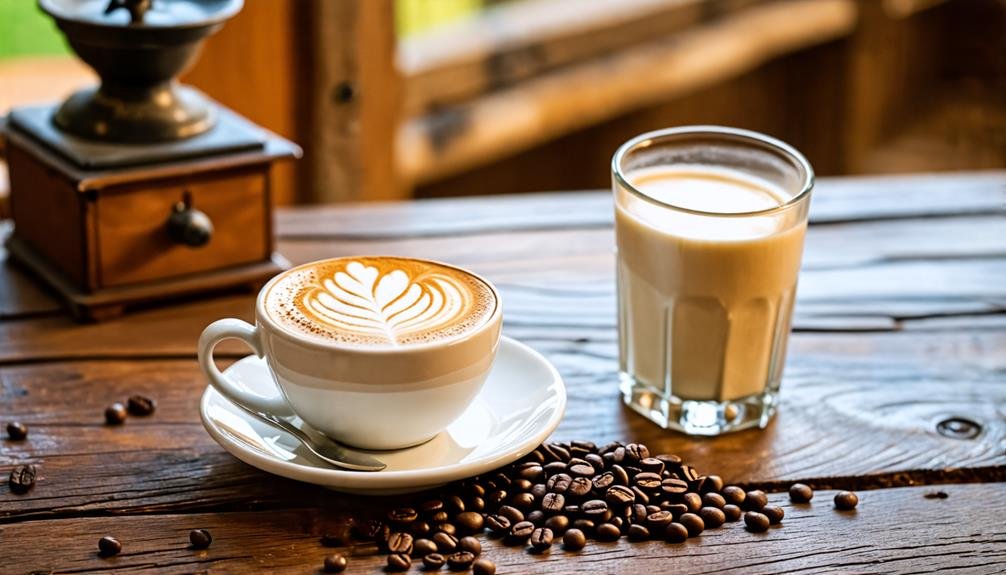
Caffè latte and cappuccino are two distinct coffee beverages that showcase Italy's rich coffee culture. While the caffè latte combines espresso with steamed milk for a smooth and creamy experience, the cappuccino features a balance of espresso and frothy milk, making it a popular choice among locals, especially during breakfast. Understanding these differences not only enriches your ordering experience but also allows for a deeper appreciation of the traditions that shape Italian coffee.
Difference Between Caffè Latte
Understanding the distinction between a caffè latte and a cappuccino is crucial for coffee lovers immersed in authentic Italian coffee culture. A caffè latte features a shot of espresso blended with steamed milk, resulting in a smooth, creamy beverage that accentuates the coffee's rich taste. This drink is typically served in larger mugs, allowing the milk to take center stage, making it a favored choice for those who enjoy a gentler coffee flavor.
On the other hand, a cappuccino consists of equal parts espresso, steamed milk, and foamed milk, creating a harmonious flavor balance. The foamed milk introduces a light, airy texture that enhances the coffee's strength. Cappuccinos are traditionally served in smaller cups, and their layered presentation offers both visual appeal and a distinct taste sensation.
Both drinks embody Italy's rich coffee heritage, catering to diverse preferences. While the caffè latte provides a comforting, milk-centric flavor, the cappuccino presents a bold coffee experience. By grasping these nuances, coffee enthusiasts can navigate the vibrant world of Italian coffee culture, enriching their enjoyment during their culinary journeys.
Popularity of Cappuccino
Cappuccinos enjoy enduring popularity in Italy. This iconic drink, known for its rich flavor and cultural importance, forms an essential part of the Italian coffee experience. It consists of a balanced mix of espresso, steamed milk, and foamed milk, making it a culinary staple. Italians typically savor cappuccinos in the morning, often paired with a delightful pastry, making it a vital aspect of their daily rituals.
The appeal of cappuccinos stems from the skilled preparation and artistic presentation involved. Baristas take great pride in crafting intricate foam designs atop the cappuccino, highlighting their expertise and enhancing its visual charm. While cappuccinos are a common choice, locals usually reserve them for the morning hours, opting for espresso in the afternoon.
Unlike modern lattes found in cafés globally, cappuccinos retain their authentic essence in Italian coffee culture. By opting for a cappuccino, visitors not only treat themselves to a delicious drink but also embrace the traditions and customs that underscore Italy's rich coffee heritage, promising a genuinely authentic experience.
The Popularity of Cappuccinos
Cappuccinos hold a prominent place in Italian coffee culture, often enjoyed as a breakfast beverage, reflecting local preferences and customs. Their popularity extends across different regions, with some areas showcasing unique foam art that elevates the drinking experience. Understanding these nuances not only enriches one's appreciation for cappuccinos but also highlights the diverse traditions that shape Italy's coffee landscape.
Breakfast Beverage Preference
In Italy, the morning ritual of enjoying a cappuccino has become a cherished tradition. This creamy, foamy beverage holds cultural significance and is preferred over other coffee options. Italians typically consume cappuccinos at breakfast, often paired with a cornetto, creating a delightful start to the day. This practice underscores the importance of savoring one's morning drink.
A cappuccino consists of equal parts espresso, steamed milk, and foamed milk. This balanced flavor profile appeals to many coffee lovers. Its popularity is not just about taste; the social aspect of coffee drinking in Italy is significant. Locals gather at cafes like Caffè Nero to enjoy their drinks together, fostering connections and reinforcing cultural ties.
Interestingly, cappuccinos are rarely ordered in the afternoon. Italians switch to espresso shots during later hours, highlighting the cappuccino's role as a breakfast beverage. This distinction solidifies its status in the daily routine of Italians. Therefore, for visitors to Italy, embracing the cappuccino tradition is crucial for experiencing authentic Italian coffee culture.
Regional Variations Explained
Cappuccinos, an iconic Italian beverage, showcase notable regional differences across Italy. In northern areas, like Lombardy and Piedmont, locals enjoy cappuccinos at any hour. In contrast, southern cities, particularly Naples, reserve cappuccinos for breakfast.
- Milanese often sip cappuccinos throughout the day, while Neapolitans adhere to the morning tradition.
- Northern Italians prefer larger servings, highlighting a variance in size and presentation.
- Specialty cappuccinos with local flavors enhance the experience in various regions.
- After lunch, many Italians opt for espresso, moving away from cappuccinos in the afternoon.
These regional distinctions emphasize the significance of local customs in Italy's coffee culture, allowing visitors to delve into the unique practices of each area and enriching their enjoyment of this beloved drink.
Unique Foam Art
Italian coffee culture features cappuccinos, which showcase the artistic skills of baristas through intricate foam designs. This foam art enhances the beverage's visual allure and embodies Italy's rich coffee traditions. A cappuccino, comprised of espresso, steamed milk, and foamed milk, is a staple of Italian breakfast.
The appeal of cappuccinos highlights the significance of presentation. Baristas craft detailed patterns, from simple love shapes to complex designs, using microfoam. Specialty cafés, like Starbucks and Lavazza, focus on mastering foam artistry, elevating a standard drink into a creative expression.
Although cappuccinos are popular, particularly in the morning, Italian customs dictate they are seldom ordered in the afternoon. Locals typically opt for a shot of espresso instead. This cultural practice emphasizes the distinct relationship Italians maintain with their coffee, where each cup serves as a chance to enjoy both taste and craftsmanship. Embracing this tradition enhances visitors' experiences in Italy.
Italian Coffee Culture Insights
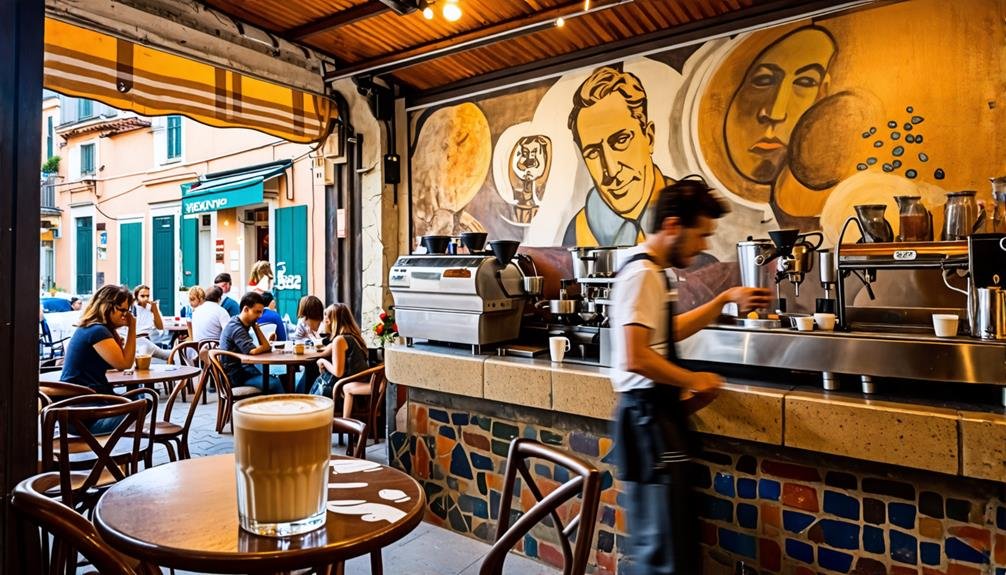
Italian coffee culture embodies rich traditions and unique customs, providing a variety of beverages that reflect local preferences and historical importance. This culture is woven into everyday life and serves as a crucial element of social interactions in Italy. Familiarity with these customs enhances your coffee experience.
- Espresso: The backbone of Italian coffee, espresso is enjoyed throughout the day, often consumed standing at the bar.
- Cappuccino: Normally savored only in the morning, cappuccinos are rarely ordered after 11 AM.
- Caffè freddo: For those in search of a chilled option, caffè freddo offers a refreshing choice, especially during the summer months.
- Café etiquette: Customers typically pay after consumption, reflecting the relaxed pace of Italian life.
Unique Regional Coffee Drinks
Italy's varied coffee culture extends beyond the well-known cappuccino and caffè latte, showcasing unique regional specialties that reflect local traditions. In Turin, for instance, the bicerin—a layered drink of espresso, chocolate, and cream—offers a delightful twist on the classic coffee experience. In comparison, Padua's patavina combines espresso with steamed milk and whipped cream, highlighting the rich variety of flavors and preparations that can be found throughout the country.
Turin's Bicerin Experience
While immersing yourself in Turin's vibrant coffee scene, you must savor the city's iconic drink, bicerin. This exquisite concoction combines espresso, rich hot chocolate, and velvety cream, encapsulating Turin's culinary tradition and its passion for bold flavors and premium ingredients.
When indulging in bicerin, keep in mind:
- Cultural Heritage: Originating in the 18th century, bicerin is deeply rooted in the elegant coffeehouses of Turin, like Caffè Al Bicerin.
- Visual Appeal: Served in a transparent glass, bicerin displays its stunning layers of espresso, chocolate, and cream, creating an inviting presentation.
- Regional Twists: Each café, such as Caffè Torino or Caffè San Carlo, may offer its own interpretation of the classic bicerin, providing diverse flavor profiles.
- Ideal Companion: Pair your bicerin with a delectable pastry, such as a cornetto al cioccolato, to enhance your Italian experience.
For an authentic taste of Turin, bicerin serves as a captivating entry into the city's dynamic coffee culture.
Padua's Patavina Delight
In Padua, the patavina delivers a unique coffee experience. This traditional drink blends espresso and warm milk, enhanced with cocoa or vanilla, creating a creamy and invigorating texture. The patavina embodies Padua's commitment to craftsmanship and quality, showcasing the city's culinary heritage.
When you explore Padua, opting for a patavina honors local tradition and reveals the region's authentic flavors. Unlike standard lattes, this beverage caters to the local taste, offering a distinctive twist that differentiates it from other Italian coffee drinks.
While enjoying the patavina, don't miss the chance to try other regional coffee specialties. Italy's coffee culture is diverse, varying greatly between cities. By indulging in local favorites, you deepen your appreciation for Italy's rich coffee traditions and enhance your overall experience of Italian culinary artistry.
The Origins of Italian Coffee
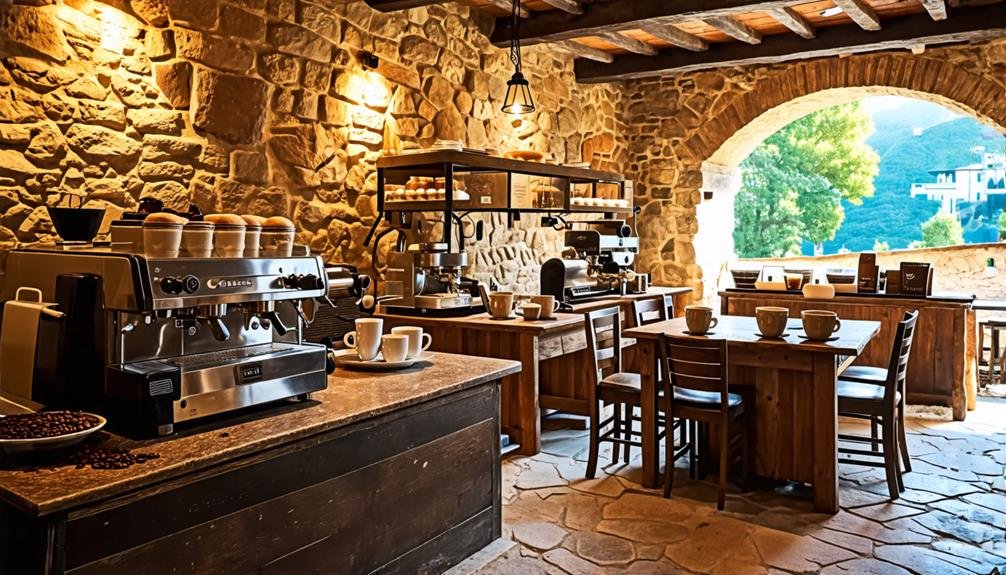
Italian coffee has a rich history marked by significant developments, starting with the introduction of the espresso machine in Turin during the 1880s. This invention revolutionized coffee preparation and established a distinctive coffee culture in Italy. By the 1940s, the iconic espresso shot with crema was perfected in Milan, further enhancing the flavors and overall coffee experience.
Notable milestones in the evolution of Italian coffee include:
- The creation of the espresso machine in the 1880s, which transformed how coffee was made.
- The introduction of the espresso shot with crema in the 1940s, which improved flavor and aesthetics.
- The emergence of the modern latte in Seattle in the 1980s, moving away from traditional Italian techniques.
- The popularity of latte art, developed by Seattle baristas, emphasizing visually appealing coffee presentations.
While Italian cafés may not feature the latest coffee innovations, they provide a diverse array of traditional coffee drinks that celebrate Italy's rich coffee heritage, inviting aficionados to explore and savor their authentic flavors.
Cappuccino Tradition Explained
Cappuccino, an iconic Italian coffee drink, represents a perfect fusion of bold espresso and creamy foamed milk, making it a fundamental part of Italy's lively coffee scene. A standard cappuccino features about 25 ml of espresso paired with roughly 100 ml of steamed, foamed milk, creating a flavor balance that emphasizes the strong coffee essence while delivering a smooth mouthfeel.
These coffee beverages are especially favored for morning enjoyment, reflecting a cultural practice where Italians opt for lighter, shorter drinks in the afternoon. This commitment to tradition is visible in the careful crafting of cappuccinos, often highlighted by artistic foam designs, which have become a signature of gourmet coffee in Italy.
Regional adaptations can be found, with certain locales introducing distinct variations on the classic formulation. The cappuccino's vital position in Italian gastronomy is clear, as it functions not just as a morning custom but also as a social bridge among acquaintances and family. Ultimately, savoring a cappuccino in Italy goes beyond simple drinking; it is an opportunity to embrace a rich legacy that honors simplicity and craftsmanship in every cup.
Embracing Authentic Italian Cafés
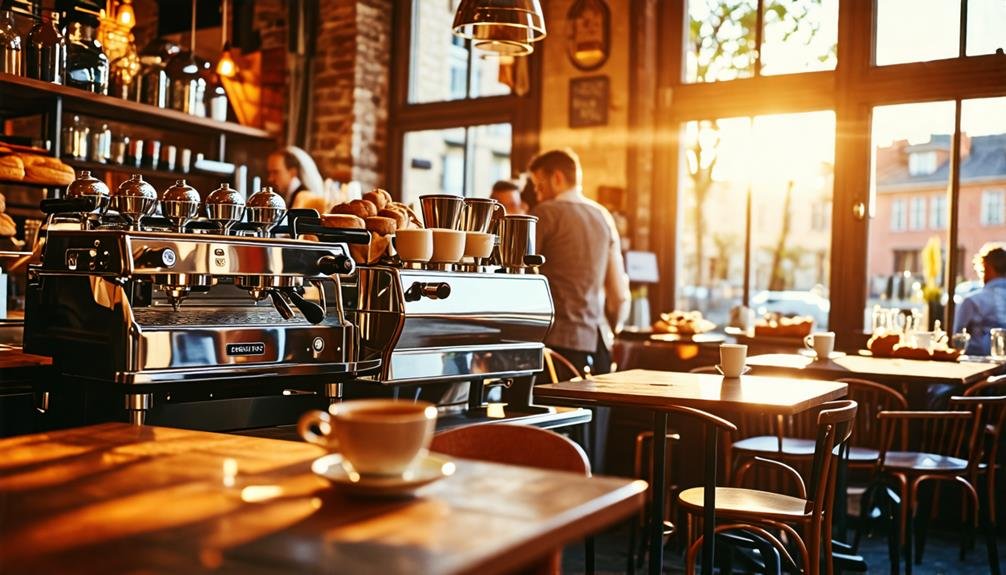
To truly savor the vibrant world of Italian espresso culture, one should seek out local coffee shops that emphasize traditional brewing techniques and regional delicacies over mainstream tourist spots. These establishments encapsulate the essence of Italy, delivering an experience that transcends simple consumption. By immersing in this environment, patrons can enjoy not only remarkable brews but also the communal traditions associated with coffee.
- Select coffee shops that feature locally sourced beans and seasonal flavors.
- Interact with skilled baristas who can guide your choices.
- Explore regional specialties, like caffè freddo during warm months.
- Familiarize yourself with local customs related to coffee enjoyment.
Every genuine coffee shop showcases unique offerings that reflect its locality, allowing visitors to experience the authentic spirit of Italian coffee. By choosing these venues, one can cultivate a richer understanding of Italy's coffee legacy, building a connection to the culture that goes beyond the drink. This exploration of genuine coffee shops encourages a celebration of the deep-rooted traditions and tastes that characterize Italian espresso culture.
Coffee Customs Across Italy
Exploring Italy's coffee customs reveals diverse preferences and rituals that vary by region. In Naples, bustling cafés serve quick caffè (espresso), reflecting the city's fast-paced lifestyle. In contrast, Milan's coffee culture embraces leisurely enjoyment; sipping a cappuccino becomes a social event, particularly in the morning.
Traveling north to Turin, one encounters the local specialty, bicerin—a layered drink combining espresso, hot chocolate, and milk, showcasing Italian coffee history. In Padua, the patavina offers a rich coffee topped with whipped cream, highlighting the region's creativity. Italians generally avoid coffee after meals, preferring to enjoy their beverages at designated times throughout the day.
These customs illustrate a profound cultural appreciation for coffee, emphasizing local traditions. Understanding these variations not only enhances the coffee-drinking experience but also connects individuals to Italy's vibrant culinary heritage.

